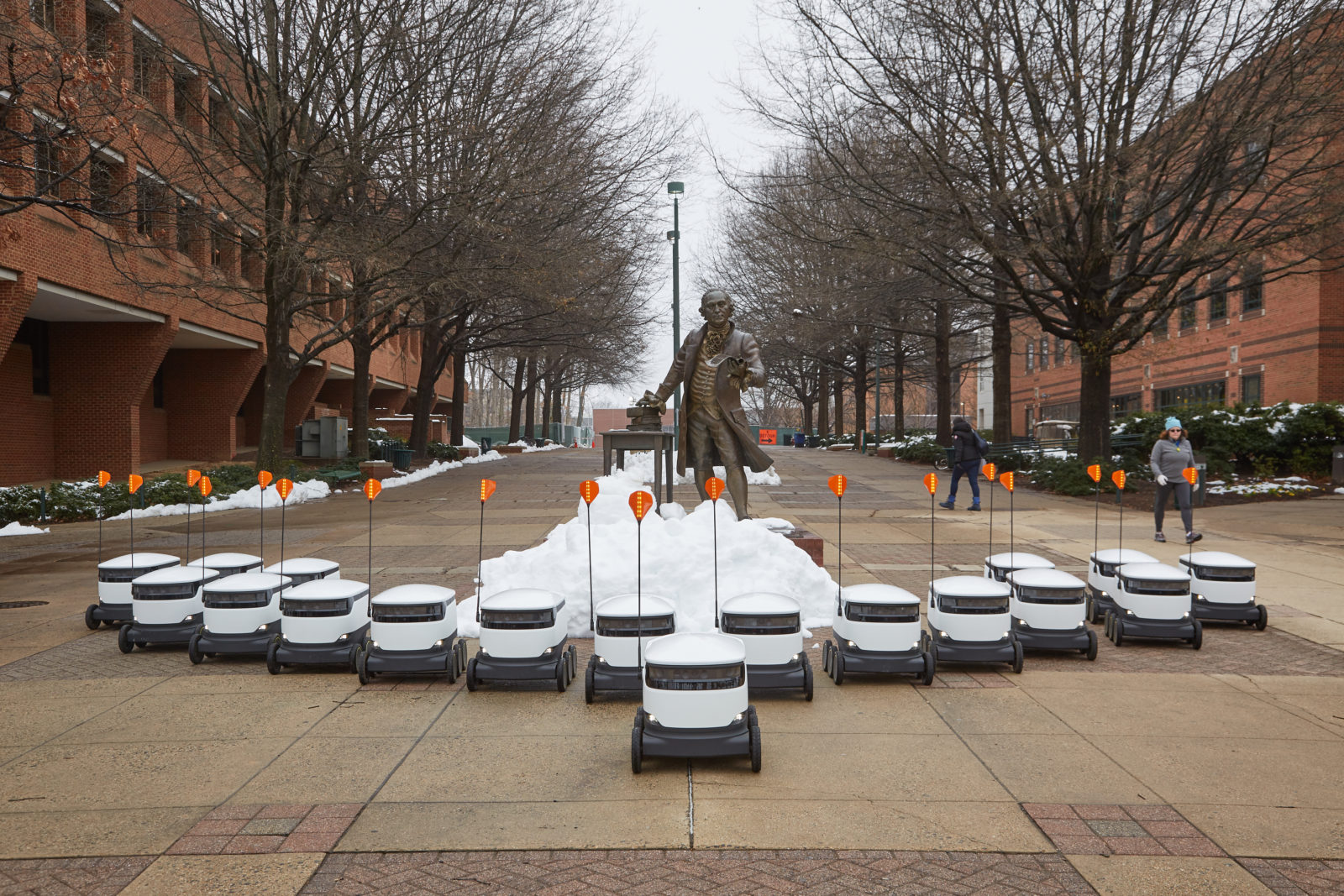Starship Technologies, an autonomous delivery service, has partnered with Sodexo to bring 25 food delivery robots to the George Mason University community to deliver goods for a delivery cost of $1.99.
The fully operational commercial service went live on Jan. 22 at the Fairfax, Va.–based campus, with participating retailers Blaze Pizza, Starbucks, Dunkin’ and Second Stop, GMU’s on-campus grocery store. The companies said more retailers will be announced in the coming weeks. This isn’t the first time Starship deployed robots on the East Coast. In 2017 the company piloted its food delivery robots right here in the District. Though the service is mainly accessible to GMU students, faculty and staff, anyone is able to download the iOS or Android Starship app to order from the list of retailers on campus. Users can also watch as the robot makes its journey to them on an interactive map. Once the robot arrives, they receive an alert, and can then meet and unlock it through the app.
“Students and teachers have little free time as it is, so there is a convenience for them to have their food, groceries and packages delivered to them. Our goal is to make life easier, whether that means skipping the line, eating lunch on the lawn rather than in the cafe, or finding the time to eat better when studying for exams,” Ryan Tuohy, senior VP of business development at Starship said in a statement. “Commuters can even meet the robot on their way into class. We look forward to seeing how our service will help and support the daily lives and community of students and educators at George Mason University.”
Starship robots are able to carry any items up to 20 pounds, meaning a user could order up to three grocery bags full of food and still only require one robot. The robots focus on making one delivery at a time, moving at four mph, and Starship says they can complete deliveries within 30 minutes. The robots operate between 8 a.m. and 9 p.m. every single day, even though some participating retailers may close earlier on the weekend.
Along with moving on campus, it marks a shift to fully operational service in the metro area for Starship, In 2017, D.C. ran a more limited pilot of the food delivery program.
Sodexo is a provider of integrated food, facilities management and other services that enhance organizational performance, contribute to local communities and improve quality of life. This partnership is the largest implementation of autonomous robot food delivery services on a campus and is representative of Sodexo’s next-generation technology portfolio for the college and university market, a Starship spokesperson told Technical.ly.
“University dining programs are evolving their strategies to meet this generation’s elevated expectations, such as better quality, variety and service delivery,” Jim Jenkins, CEO of Universities East at Sodexo USA. “George Mason University’s culture of innovation and early adoption makes it the perfect campus for Sodexo and Starship to introduce this cutting-edge technology and enhance the campus experience for the entire school community.”
In all, Starship robots have completed over 25,000 deliveries and travelled more than 150,000 miles by using a combination of sophisticated machine learning, artificial intelligence and sensors to travel on sidewalks and navigate around obstacles. The video below shows how the robots will even navigate around people in its way:
So how do the robots handle human interaction? A Starship spokesperson said throughout all of the trips Starship robots have taken, they haven’t had any cases where humans want to harm the robots and barely want to interact with them. The robot is locked and has alarms, as well as audio and camera tracking. It’s also equipped to play audio messages through the robot, and an alarm will sound if someone tries to tamper with the robot.
As far as handling, the robots can drive 99-percent autonomously in a pre-mapped area, the Starship spokesperson said, so the robots only need human control during its first run in a new area. Once routes are mapped, the robots are autonomous, but they turn to human operators for assistance when making decisions if they get into unexpected situations or social interaction. Under the company’s model, a person sitting remotely can have oversight of many robots at the same time.
At the conclusion of their workday or when in need of a charge, the Starship robots will report to pods on campus where they will be housed with an automated system that will switch out any batteries when their energy is running low.
The companies said they have plans to expand the food delivery robot program to additional campuses in the future.







